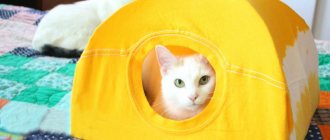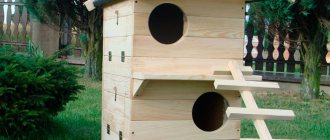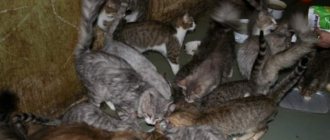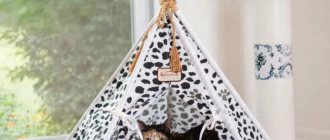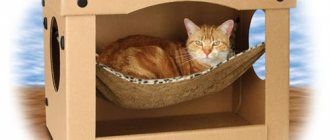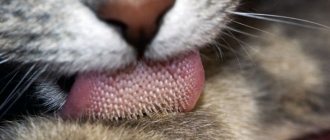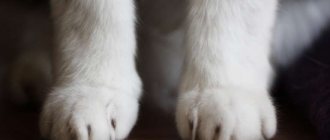If your pet regularly climbs into closets, hides in various places and scratches the upholstery, then try creating an original and secluded place for them - a cat house.
Making such a corner is not as difficult as it might seem at first glance. A home made with your own hands will be the most wonderful gift for your cat. He will spend most of his time in it, playing and relaxing.
Of course, you can purchase a store-bought version, but making the product yourself is much more interesting. And this way you can arrange a cat corner, guided by the preferences of your pet.
Types of houses for cats
Having a home for cats is considered an important condition for their comfortable living in an apartment. This is their corner where they can retire, sleep peacefully or play. For this reason, it is worth considering the design in advance and choosing the appropriate dimensions and shape. If you wish, you can even create houses for cats with your own hands.
For mustachioed friends, there are different homes - from beds with sides to large play areas. Their use is also different - for relaxation or for games. Depending on the size of your house or apartment, you can choose any model. For pets, a cardboard or wooden house would be an ideal option: it is considered safe and environmentally friendly and will not have a negative impact on the pet’s health.
Loungers and hammocks
A hammock or bed will become a cat’s favorite corner: the pet can sleep in it with maximum comfort. The design follows the shape of the animal's body - this allows you to sit comfortably on the lounger.
A DIY cat bed can be made from the following materials:
- felt fabric;
- Velcro;
- strong threads;
- tape that will be used for sheathing.
A small hammock will be fixed on a chair - for this reason, the size of the material should be selected in accordance with the width between the legs of the furniture. It is not recommended to use smooth tapes for production, because they quickly deteriorate.
The process is carried out step by step:
- We strengthen the base of the hammock by sewing tape along the edges.
- It is possible not to use Velcro to fix the suspended structure: you can use tape and make loops out of it.
- At the end, the finished house should be secured on a chair.
To make your homemade bed comfortable and soft, you can fill it with foam rubber. It is worth considering the compatibility of materials: the product must be harmoniously combined with the interior of the room.
Options for small apartments
In a small room it is convenient to use a hanging hammock as a cat bed. It can be easily attached to chair legs. An old T-shirt or towel can become a hammock. It does not take up much space, it is convenient to clean and wash. A hammock knitted or sewn from leftover fabric is not only a temporary solution (while you are building the main house), but also an additional attribute for your pet’s life.
Furniture will also serve as options for the house. The ottoman is equipped with an entrance, and in the bedside table you can arrange both a feeding trough and a shelter by cutting the necessary holes. For two or more cats, choose a multi-level house with hiding places for each animal. This will help save surrounding space.
In any room there is an empty corner, into which the corner version of the house will harmoniously fit. It does not take up useful space and is suitable for apartments with a small area. The corner house is made of plywood or wood. It is suitable for both acute and obtuse corners of the room, because the project is created according to the individual measurements of the room.
Built-in furniture cat house
Creative house for cats
Plywood booths
If you want to make a tall house in which your cat will be protected, then you should pay attention to plywood options. They are made simply, and the end result is a spacious and comfortable home for a beloved friend who can relax in it. If necessary, it can be taken outside or installed on a balcony or window sill.
To begin, you should prepare:
- sheets of plywood material (willow or oak are suitable);
- profile with an angular shape;
- screws;
- carpet
Step-by-step instructions for making a cat cottage:
- We fasten the main parts of the cat’s future home using a profile. We drill holes.
- We cover all sides of the finished product with carpet on the outside. But for the inside you can use foam rubber.
- If the walls are placed in a continuous row, then you need to make a hole for the entrance.
Manufacturing options for various models can be found on the Internet.
Built into furniture
If your cat does not like noise and increased attention, then his house should be protected. A dwelling disguised as an interior will fully meet this goal. It will please both the pet and the owner.
A good option would be to arrange a house in the bottom drawer of a closet or chest of drawers. It is freed up for the pet, bedding and several of the cat's favorite toys are placed in it. A hole is made on the front surface for the door.
If you wish, you can make a cozy corner for the animal in a flower stand, in a coffee table or in an armchair with a drawer for linen. It is important that your pet can get in and out freely. A soft pouf is also perfect for creating a house.
Veterinarian advice on choosing a home
When choosing a suitable home, you should take into account the psychology of cats - each individual pet. It is important to evaluate the character, age, weight of the animal, and its habits. If a cat likes to sleep in a closet, between sofa cushions, a soft, maximally enclosed house with a roof will suit him. For cats who sleep on a radiator, a laptop keyboard, or other “warm” household equipment, a chimney house suspended in the coziest place, a bed upholstered in woolen fabric, is suitable. When an animal prefers to sleep on the owner’s sofa, bed, or chair, a small bed on a hill or a cat mini-sofa will suit it.
Those who like to climb to the very top are offered a series of hanging shelves and a booth with a high upper platform. Neutered, simply clumsy, overweight pets will never climb into a shaky, unstable home, so for them the option is chosen that is firmly fixed in the corner, with a strong, wide ladder.
When choosing manufacturing materials and finishing, preference is given to natural ones that are not harmful to health, even if small particles get inside - cats love to taste everything, scratch surfaces with their claws, and then wash their paws with their tongue. A foam mattress may have a removable cover, which is periodically machine washed. The main thing is that the home should not have any foreign odor; this indicates the presence of harmful dyes in the composition that can cause allergies.
The size of the bed is also important: it should not be too spacious for an adult pet - most cats prefer a “bed” that is slightly larger than themselves. The house is made a little more spacious - its height should allow the animal to calmly stand on four legs, move, and turn. If there are several cats, they like to sleep nearby, making the home even more spacious for the mother and kittens. For sick, very old, injured pets, a spacious bed or house with a removable top is required. If necessary, a heating pad should be placed here, and it should be possible to eat food right on the spot. A mattress for non-walking cats is covered with disposable diapers or placed under regular flannel oilcloth. In case of skin or infectious diseases, the house must be disinfected, all textiles must be washed at maximum temperature. Animals that are visually impaired or have one blind eye are often afraid of closed houses, preferring open beds on the windowsill, where there is enough light.
Cardboard house
A DIY cat house made from a cardboard box will be a practical option that is suitable for your pet. This material is easy to work with: it can be cut, glued, and covered. The main thing is to choose a good and spacious box.
The process of making a box home is quite simple:
- To begin, take the box and cut out a round hole in one part in the center that will serve as the entrance. A regular plate with a round shape is suitable as a template.
- The upper part will serve as a roof. We cut off the cardboard above the entrance and the parallel part to it.
- We connect the sides of the box - we get natural ventilation.
- Next, we cover the home with fabric and decorate it.
You can place a soft pillow and several pet toys inside.
Game complexes
Keeping cats gives owners a lot of trouble and problems. They play, run, sharpen their claws, thereby causing damage to furniture and interior items. To eliminate these troubles, you can build a large two-story play complex in which your pet can play.
To manufacture the complex you will need:
- boards and plywood for the frame part. If these materials are not available, then you can use drywall;
- tubes made of metal or durable plastic;
- multi-layer upholstery material, foam rubber;
- cords, ropes, rope;
- screws;
- You can use a construction stapler for fastening;
- liquid Nails.
To make an exclusive gaming complex, it is worth preparing additional materials:
- wooden houses with an entrance;
- hanging hammocks with several fastenings;
- observation decks;
- play tunnels;
- stair elements;
- ottomans;
- suspended balls;
- scratching posts;
- columns that connect the entire structure.
After preparing the materials, you can begin building the main structure. It is performed in stages:
- The main structure for the cat is built in the form of platforms and shelves. Using a jigsaw, two sheets are cut out of plywood, which will be the top and bottom. The bottom part should be larger than the top.
- Three holes are made in the blanks. The size of their diameters must correspond to the diameter of metal or plastic tubes. They will serve as supports.
- A sun lounger can be installed on the top of the structure.
- Next, all materials are upholstered with fabric.
- Then a post is installed that will serve as a scratching post and a surface for moving the cat around the play complex. To do this, take a tube and cover it with a rope cord. The last edge of the rope can be fixed with liquid nails.
At the end there are additional materials that will be used for the pet's games.
What you need to know when making your own houses
Cat houses are made from a variety of materials, preferably natural, and consist of a rigid frame, if the design allows for one, and soft upholstery. When creating hanging products, you should carefully secure them - the fall of an adult cat along with the house often leads to serious injuries, and for a kitten it can be fatal, even if the height is only a meter.
Selection of base material
Most often used to make the frame of a cat house:
- natural wood;
- MDF;
- Fiberboard;
- laminated chipboard;
- plywood;
- thick cardboard;
- plastic;
- paper tubes;
- rattan.
A homemade booth, shelf, or play complex can be constructed from any boards, remnants of wooden paneling or laminate, large plastic containers, corrugated boxes, papier-mâché. It is important that the materials are not painted with toxic compounds and do not have an unpleasant pungent odor. Wicker basket houses are made from newspaper and magazine tubes, strips cut from plastic bottles, wicker, pine roots, and rattan.
The frames of scratching posts and stands are made from plastic and metal pipes.
Sheathing material
Most cats prefer to sleep on a soft surface; the upholstery for a house or bed is:
- artificial fur;
- carpet;
- furniture upholstery fabric;
- foam;
- padding polyester
In the play complex, all surfaces are covered with fabrics, except for scratching posts; the stands are wrapped with hemp rope and twine. Mattresses and pillows are filled with padding polyester, foam rubber, and special granular material that retains heat.
Long-haired and heavily shedding pets are given bed houses from which the hair can be easily removed. The upholstery is selected to be as close as possible to the color of the cat’s coat – so individual hairs are hardly noticeable. As an option, choose a color to match the walls, curtains, furniture upholstery, and carpet in the room.
It is not advisable to use highly electrified fabrics.
Methods of fastening parts
When creating cat houses, plastic and metal corners are used, attached in such a way that the animal cannot be injured by them. Fabrics and soft parts are fastened with a construction stapler; nailing is not recommended - over time, the structure becomes loose, nails come out, which can become dangerous. When using glue, PVA or any other glue is suitable, but without a strong odor. Houses made of carpet, having a tubular, drop-shaped shape, are attached to a stable metal frame with wire and carabiners. Cardboard products are secured with tape.
When using metal parts, they must all be covered with a cloth or sealant, since friction with cat hair creates static electricity that can harm the animal.
Cat tent
A tent for a cat or dog made from an ordinary T-shirt looks interesting. This interior version of the home is simple to make; it does not require much effort or large financial investments. You can take it with you to the country or nature.
To make a tent you will need the following materials:
- medium size T-shirt;
- a small piece of cardboard 40x40 cm;
- two wire hangers;
- scotch;
- pins;
- pliers.
The manufacture of a tent is carried out in several stages:
- Using pliers, bite off part of the hanger with the hook so that the outline opens.
- Two hangers should be bent in the form of semicircles, they should be the same.
- The two pieces of cardboard are held together with tape.
- A through hole is made in each corner of the cardboard; you can use an awl for this. The holes should be 1.5-2 cm away from the edge.
- Semicircles of hangers are crossed, the central part is fastened with tape.
- Next, we insert the structure into the holes in the corners of the cardboard, the parts of the hangers coming out of the holes are bent with pliers and rewound with tape.
- We pull on the T-shirt, the collar will serve as the entrance.
At the end, all sleeves are folded to the bottom and secured with pins.
Houses with scratching post
Every cat needs to sharpen its claws. If your pet is indoors and it is not possible for him to go outside regularly, then he will have to do this at home. Without the claw grinding procedure, the owner will have to trim them.
And if there is no scratching post in the house, the pet will begin to sharpen its claws on the furniture.
Therefore, it is better to make a house for a cat with a scratching post, which will fully perform its intended function.
Don't forget about the scratching post
Materials
First decide on the construction site. Then you need to measure the allotted “angle” in height and width. Now prepare the materials most convenient for sharpening the animal’s claws. This:
- carpet;
- tapestry;
- jute rope;
- fur;
- tree.
A good option with a scratching post
Carpet is a fairly durable and soft material. The cat will sit comfortably on it and also comfortably sharpen its claws on it.
In addition, you will need:
- plywood sheets;
- wooden beams;
- plastic pipes as support pillars;
- self-tapping screws;
- corners;
- screwdriver;
- jigsaw
Choose a variety not only according to taste, but also according to convenience.
But these tools may not be found in the house. Therefore, it is worth taking care of their availability in advance.
What and where to buy?
To build a hut with a scratching post for an animal, buy a whole sheet of plywood at once - 1.5 by 1.5 cm. Then cut it into pieces: 0.50 by 0.75 cm.
For the support (post), you can use a regular beam, which will need to be divided into several parts. Choose timber up to 2.5 m long.
Sketch first before making
It is advisable to choose plywood sheets with a thickness of at least 10 mm. Since the cat will often jump on them in the future. And this material must be strong.
Advice Do not buy the most expensive carpet. Give preference to the cheap option. You can also ask the seller to sell you scraps of this material.
Jute rope can be found in every hardware store or market. The difficulty is that it is sold in bulk . You'll have to buy a whole skein or look for a store that sells rope by the meter. But the price of a cut product is much higher. Take a rope at least 1 cm thick.
Budget and convenient
Safety fastening elements are purchased for the building: corners and triangles for better fixation of structures.
Manufacturing process
When the design of the hut is completed and all materials are at hand, you can begin to work. The basic frame can be one-, two-, or even three-tiered. The number of platforms also depends on the number of cats in the house. So, if two pets live in an apartment, then each of them should have its own seat.
When a scratching post is replaced by a house
So let's get started:
- A wooden beam is attached to the plywood base.
- You can put a plastic pipe of suitable size on it (so that the pipe fits tightly to the walls of the beam and does not twist).
- If we make several platforms, then at some distance from each other on a single base we fix 1-2 more beams.
- Each of them has its own platform (at different heights). We fix them on top with self-tapping screws and metal corners on the sides.
Make designs easy to carry
- The first shelf must be fixed not only to its beam, but also be connected to the second. Therefore, a hole for the second beam is prepared in advance in the plywood. He will have to go on the board. The second shelf is attached to the third in the same way.
- Now you can begin framing the plywood surfaces with carpet. Here you can use a stapler or use regular nails and a hammer. If you decorate the house with ordinary fabric, then soon the building will need its replacement. Most likely the animal will want to sharpen its claws on the fabric too.
- Tie all the pillars from beginning to end with rope. Try to keep their rings tightly adjacent to each other.
Now the scratching post structure for your pet is ready! Additionally, you can decorate it with colored felt, threads with buttons, sparkles, and foil.
Original furniture for cats
In order for the cat to fully develop, play and relax in the house, it is worth thinking through everything down to the smallest detail. There is a variety of furniture and accessories for animals that can not only diversify the leisure time of mustachioed animals, but also fit into the overall interior in an original way.
Let's look at a few unusual options:
- bookshelves. These products will perfectly complement a library or children's room;
- table with grass. In this design, there is a glass container with soil at the bottom. You can put the seeds of your cat's favorite grass in it;
- functional rocking chair for you and your pet. It will allow you to combine relaxation with your mustachioed friend.
You can also make a sofa with a cat tunnel. This unusual designer piece of furniture can fit perfectly into any interior style.
General requirements for a house for cats
Materials for making a cat house should be safe, but not necessarily expensive. The most affordable things that can be used for a frame are thick cardboard, chipboard, plasterboard, plywood, wooden boards and bars. To fasten parts, it is better to use furniture fittings, nails, screws, ropes, threads. Glue, if necessary, is best used for the construction of external structures such as beds and scratching posts.
When assembling the body of the house, it is better not to use adhesives, since not only the strong smell, but also the toxicity of some types of adhesives can harm the health of the cat.
For upholstery, you need to take old things: sweaters, T-shirts, trousers, after washing them. If this is a scratching post, then it could be carpet, an old carpet, or a thick rope.
The main thing is not to rush when building a cat house: avoid crooked joints, make sure that nails and screws do not stick out, carefully handle the edges of the boards, and remember the required strength.
Having a reliable rear in the form of its own territory, where an uninvited guest will not penetrate, the cat will always be confident in its safety, which means it will be able to devote more love to its owner.
How to make a cat house from scrap materials
Houses for cats can be different; it is not necessary to use wood, plywood or cardboard to make them. A cat house can be made from the following means and materials:
- made of fabric, thick felt. You should first create patterns, and in order for the product to hold, it can be strengthened;
- housing for the animal can be organized in an old suitcase, which is lined with fabric on top;
- If you have unnecessary plastic containers or basins at home, you can put them to use. If properly designed, they can become a wonderful home for a member of the cat family;
- an old basket can become a cozy nest for a pet. The main thing is to properly design and arrange it.
If you wish, you can build a wonderful home from foam plastic. It can be covered with fabric or painted with acrylic paint, and a soft mattress or foam rubber can be placed inside.
What materials can be used
A variety of materials can be used in production. I will describe all the elements of the product and tell you what materials these parts can be made from.
Sleeping area
There should be a rigid frame with a roof (if you are making a house) or without (if it is more of an open or partially open bed) and a soft bed. To make a frame you can use:
- tree;
- cardboard;
- plastic;
- light metal tubes;
- plywood and chipboard;
- textile.
Litter
sewn from fabric and filled with printed material:
- foam;
- padding polyester;
- straw;
- foamed polystyrene or other special granules.
A claw sharpener is made from a piece of wood and winding - you can use synthetic ropes and natural jute or hemp.
House for a cat from a pipe
For a cat, cat or kitten, a home made from an ordinary pipe will be comfortable. To make it, cut off the middle piece of plastic pipe (70-80 cm will be enough). Additionally, at the bottom, so that the dwelling can stand, we attach a base - it can be made from a longitudinal cut of material.
We paint the surface with acrylic paint. Inside we place a soft cloth, carpet or a piece of foam rubber on which the pet can sleep peacefully. Additionally, you can put a small pillow inside.
Hanging cat house and shelves
Suspended housing is an original solution. The pet will feel comfortable in it, and the unusual product will fit perfectly into the overall design of the room.
Manufacturing Features:
- To create the structure, it is worth preparing a cubic plywood base. We make an opening and a small window in it.
- Next we build a bridge. For these purposes, you will need a cable, which is supplemented with cut strips of birch plywood and gaskets.
Finally, we lay rugs on the surface of the house and shelves. They are attached with glue. Below in the photo you can see a version of the finished solution.
Tent for a cat
Many cats love boxes that they constantly climb into. You can build a comfortable tent from them. The principle of making a tent is the same as that of a tent.
For production you will need:
- cardboard box;
- wire hangers;
- t-shirt.
A large box can be trimmed slightly in height.
Bed made from an old sweater
If you have an old knitted or knitted sweater or jacket lying around that you haven’t worn for a long time, you can adapt it for cat housing. Additionally, it is worth preparing the filler, threads, needles, pillow, pins and scissors.
The process of creating a home is as follows:
- You should start with the neck: it needs to be sewn. Then we sew a transverse line between the sleeves.
- The back and sides are filled with polyester.
- We sew the cuffs.
- We place a pillow inside.
- Sew up the bottom hole and attach the sleeves to the base with pins.
- Sew and remove the pins.
The product is ready! You can decorate it according to your own taste.
Basket and house made of newspaper tubes
A home made from newspaper tubes will look unusual and beautiful. It is made easily and from scrap materials that everyone has at home. Prepare the following:
- old newspapers and magazines;
- ruler;
- scissors;
- pencil;
- long knitting needle or hook;
- paper glue;
- PVA glue.
First we make newspaper tubes:
- It is recommended to cut a newspaper sheet into strips of 8-10 cm. A knitting needle is placed on the edge of the newspaper strip at an angle of 45-60 degrees.
- The strip is tightly wound on a knitting needle, and its edge is fixed with glue. Then carefully remove the knitting needle. The thickness may differ from different sides, but this is necessary so that the tubes can be inserted into each other.
Next, let's start making the home:
- We cut out the bottom of the future structure from thick cardboard; it needs to be created in two copies.
- We glue a wicker circle of tubes to the inside of one part of the bottom; they should radiate in different directions.
At the end, we glue the second bottom piece on top - it will cover the ends of the tubes.
Justification for the choice of materials for the house
The product can be made from any hardwood. The most suitable for these purposes are deciduous trees such as birch, aspen, and linden[6].
Aspen is a silver-colored, soft wood. It is well processed, but compared to linden, it is more fragile.
Birch is a medium hard wood. It polishes well, you can make small patterns, but it is much more difficult to cut than aspen or linden.
Linden has soft, fairly viscous white wood with a uniform structure. It is equally easy to cut along and across the fibers[1].
Material selection criteria
Plywood is a layered wood material obtained by gluing 3 or more sheets of rotary-cut veneer, with cross-oriented fibers in adjacent layers. The outer layer of plywood is called the jacket. The jacket is made from higher quality wood than the inner layers.
The outer layers always have the same grain direction to prevent warping of the plywood. The inner layers have parallel fiber direction. Plywood is made from pine, poplar, spruce, alder, birch in the form of leaves with a thickness of 1.5 to 18 mm, a width of 600 to 1830 mm, and a length of 850 to 2440 mm.
Sheets with a thickness of more than 18 mm are called plywood boards[7]. For manufacturing, it is necessary to select healthy and high-quality plywood: clean and uniform in color, without knots, cracks or chips, well dried and undamaged; free from areas affected by rot or fungus.
Birch plywood. A novice sawing enthusiast uses birch plywood. Birch plywood is easy to process. The material is most suitable for cutting with a jigsaw. Sheet thickness from 4 to 10 mm. Available materials that can be purchased in our store are linden and birch plywood. Thus, I chose birch plywood as my choice of material for the house. it is easy to process [4].
Choosing house upholstery. The upholstery of the house will allow it to fit into the interior of the apartment. Galina Vladimirovna's apartment is in light colors, so I chose white faux fur.
Faux fur is anti-allergenic and will not cause allergic reactions or irritation in the cat.
Developing a concept for making a house for a cat
When choosing, I took into account:
- My skill level.
- This product is a necessity for me.
- Costs of purchasing materials and tools for work.
- The amount of time required to complete a product.

